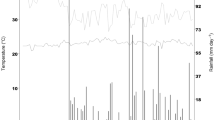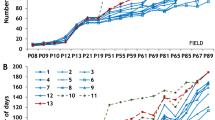Abstract
Increasing the potential of seed production has always been a priority and a necessity in breeding programs. However, the productivity of common bean varieties is a complex trait. It depends on the genotype, its morphological features, and resistance to major diseases, pests, and abiotic stressors. The basis of our research lies in the targeted study of the main elements of productivity, their contribution to the seed yield, and the limits of their variability. Experiments were conducted in the rotation of the Laboratory of Legume Crop Breeding of the Federal State Budgetary Scientific Institution “Federal Scientific Center of Legumes and Groat Crops” (FSC LGS) on the plots of 6 m2. We carried out analyses, records, and evaluations following the methodological guidelines. The research objects are collection specimens of the Federal Research Center N. I. Vavilov All-Russian Institute of Plant Genetic Resources and the varieties bred in the FSC LGS. The research results (2018–2020) allowed us to identify the main elements of the crop structure and their sources: by the number of beans and seeds per plant—Nerussa, k-15665, and Strela; by weight of seeds per plant—Dnepropetrovskaya bomba, k-15714, and k-15665; by weight of 1000 seeds—Rubin and Markiza. Based on the assessment of the vegetation period and following the “Classifier …, 1984,” we graded the plants into the following ripeness groups: mid-season (81–90 days)—46.7%, early-season (65–70 days)—13.3%, middle-early (71–80 days)—20%, and full-season (91–100 days)—20%. The main criterion for evaluating productivity was the seed yield from the area (t/ha). In the three years of the research, the maximum yield of seeds was obtained in the mid-season variety Strela—2.95 t/ha, which is 0.55 t/ha higher than the standard (Heliada—2.40 t/ha).
Access this chapter
Tax calculation will be finalised at checkout
Purchases are for personal use only
Similar content being viewed by others
References
Akulov AS, Borzenkova GA, Vasilchikov GA, Golopyatov MT, Zotikov VI, Miroshnikova MP, Gogolev GA (2010) Perspective resource-saving technology of bean production: guidelines. Rosinformagrotech, Moscow, Russia
Avramenko MN (2018) Comparative evaluation of common bean varieties in a collection nursery. Bull Belarusian Agric Acad 2:81–84
Bareke T (2019) Diversity and genetic potential of various morphological traits among common bean (Phaseolus vulgaris, Fabaceae) Landraces. Biodivers J Biol Divers 20(11):3237–3245. https://doi.org/10.13057/biodiv/d201116
Budanova V, Lagutina L, Korneichuk V, Pastorek N, Uzhyk M, Gofirek P, Odengal V (1984) Wide uniform classifier of the council for mutual economic assistance and the international classifier of the council for mutual economic assistance of cultivated species of the genus Phaseolus L. USSR, Leningrad
Budanova V, Lagutina L, Korneichuk V, Pastorek N, Uzhyk M, Gofirek P, Odengal V (1985) International classification of the council for mutual economic assistance of cultivated species of the genus Phaseolus L. USSR, Leningrad
Dospekhov BA (2012) Methods of field experiment (with the basics of statistical processing of research results): textbook. Russia, Moscow
Ganesan K, Xu B (2017) Polyphenol-rich dry common beans (Phaseolus vulgaris L.) and their health benefits. Int J Nat Sci 18(11):2331. https://doi.org/10.3390/ijms1811233
GOSSORT COMMISSION (2021) State register of breeding achievements approved for use. Retrieved from https://gossortrf.ru/en/gosreestr/
Kolmakov YV, Kazydub NG, Zelova LA, Kling AP (2013) Bean component in bakery and confectionery products. Omsk State Agrarian University named after P. A. Stolypin, Omsk, Russia
Kurlovitch BS, Repyev SI, Schelko LG, Budanova VI, Petrova MV, Buravtseva TV, Malysh LK (1995) Gene pool and breeding of cereals and legumes (lupine, vetch, soybeans, and beans). In: Kurlovitch BS, Repyev SI (eds) vol 3. N. I. Vavilov All-Russian Institute of Plant Genetic Resources (VIR), St. Petersburg, Russia, pp 323–416
Markov P, Markov D, Vodenicharova A (2016) Healthy and dietary characteristics of grains on the basis of medical evidence: a science. Thought: electronic periodic magazine, 12. Retrieved from http://wwenews.esrae.ru/. Accessed 10 March 2021
Miroshnikova MP (2015) Contemporary gene resource and directions of haricot bean breeding. Zemledelie 4:43–45
Miyutz OA (2020) Different views on the history of the origin of the common bean (Phaseolus vulgaris L.). In: Proceedings of the international scientific and practical conference of young scientists and specialists “the role of young scientists in solving current agricultural problems: trends, innovations, and prospects”, Federal State Budgetary Scientific Institution “Federal Scientific Center of Legumes and Groat Crops”, Orel, Russia, pp 118–123
Stakanov FS (1986) Beans. Kishinev, Stiintza, USSR
Van Etten J, De Sousa K, Aguilar A, Aguirres MB, Coto A, Dell’Acqula M, Steinke J (2019) Crop variety management for climate adaptation supported by citizen science. https://doi.org/10.1073/pnas.1813720116
Vishniyakova MA, Seferova IV, Buravtseva TV, Burlyaeva MO, Semenova EV, Filipenko GI, Drugova EV (2010) VIR global collection of grain legume crop genetic resources: replenishment, conservation and studying. N. I. Vavilov All-Russian Institute of Plant Genetic Resources (VIR), St. Petersburg, Russia
Zaitsev VN, Miroshnikova MP (1999) Some aspects of grain bean breeding for early-seasoning and manufacturability. In: Zadorin AD (ed) Biological and economic potential of legume and cereal crops and ways to realize it, Trud Regional Printing House, Orel, Russia, pp 199–202
Zotikov VI, Sidorenko VS, Gryadunova NV (2018) Development of production of leguminous crops in the Russian Federation. Legumes Groat Crops 2(26):4–10. https://doi.org/10.24411/2309-348X-2018-10008
Author information
Authors and Affiliations
Editor information
Editors and Affiliations
Rights and permissions
Copyright information
© 2022 The Author(s), under exclusive license to Springer Nature Switzerland AG
About this paper
Cite this paper
Miyuts, O.A., Miroshnikova, M.P., Yatchuk, P.V. (2022). Interpretation of Features of Seed Productivity of Common Bean (Phaseolus Vulgaris L. Savi) of Different Ripeness Groups in Breeding for Early Ripeness. In: Popkova, E.G., Polukhin, A.A., Ragulina, J.V. (eds) Towards an Increased Security: Green Innovations, Intellectual Property Protection and Information Security. ISC 2021. Lecture Notes in Networks and Systems, vol 372. Springer, Cham. https://doi.org/10.1007/978-3-030-93155-1_17
Download citation
DOI: https://doi.org/10.1007/978-3-030-93155-1_17
Published:
Publisher Name: Springer, Cham
Print ISBN: 978-3-030-93154-4
Online ISBN: 978-3-030-93155-1
eBook Packages: Intelligent Technologies and RoboticsIntelligent Technologies and Robotics (R0)




